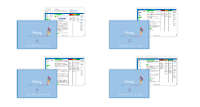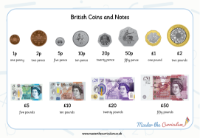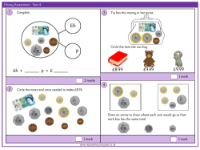Money - Vocabulary

Maths Resource Description
In the context of Year 4 money vocabulary, 'money' refers to coins and notes used to purchase items. The term 'currency' denotes the system of money in use within a particular country; for example, the United Kingdom uses pounds and pence, while the United States uses dollars and cents. 'Pence' is a unit of currency in the UK, where 100 pence equals one pound, and the symbol 'p' represents pence. The various denominations of pence include 1p, 2p, 5p, 10p, 20p, and 50p.
'Pounds' are the larger currency unit in the UK, with the symbol '£' representing them. The concept of a 'decimal point' is introduced as a dot used to separate whole numbers from fractional parts, which is essential in representing amounts that include both pounds and pence, such as £2.56. The process of 'partitioning' involves splitting up currency into pounds and pence. To 'convert' is to change money from one form to another, such as converting pence into pounds and vice versa. 'Equivalent' means having the same value; for instance, 100 pence is equivalent to one pound. 'Order' involves arranging monetary values according to a rule, like from greatest to smallest or vice versa. 'Ascending' and 'descending' order refer to sequences arranged from smallest to largest and largest to smallest, respectively. 'Estimate' means to make a reasonable guess about an amount, while 'underestimate' and 'overestimate' refer to guesses that are too low or too high. 'Approximately' indicates an amount that is not exact but close enough for practical use. Finally, 'round down' and 'round up' are methods used to adjust amounts to the nearest pound or ten pence, depending on whether the amount is closer to the lower or higher end of the scale.



